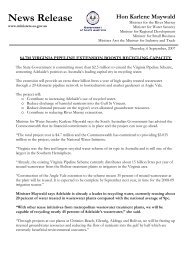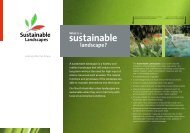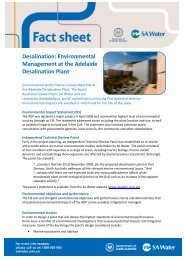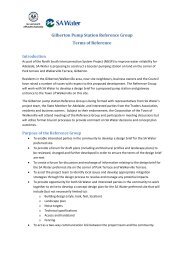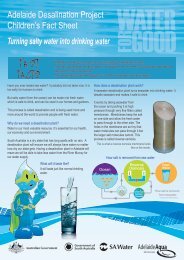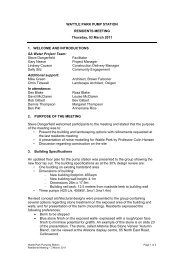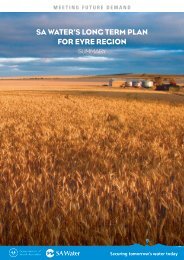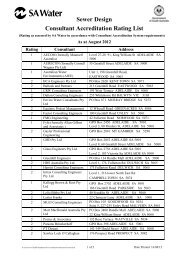Code of Practice - Irrigated Public Open Space - SA Water
Code of Practice - Irrigated Public Open Space - SA Water
Code of Practice - Irrigated Public Open Space - SA Water
Create successful ePaper yourself
Turn your PDF publications into a flip-book with our unique Google optimized e-Paper software.
5.8.2 How much water is stored in the soil?<br />
Total Available <strong>Water</strong> (TAW)<br />
The amount <strong>of</strong> water stored in the soil and available to the<br />
plant is referred to as the Total Available <strong>Water</strong> (TAW).<br />
When the soil reservoir is full it is said to be at field<br />
capacity. Any further water applied to the soil will either<br />
run-<strong>of</strong>f or be lost below the root zone by drainage. Plants<br />
will extract water from the soil as required until the<br />
remaining water in the soil is no longer able to be taken in<br />
by the plant. This is called ‘wilting point’. If water is not<br />
applied, either through natural rainfall or irrigation, the<br />
plant will become stressed to the point where it will die.<br />
The total available water in the root zone is the difference<br />
between the water content at field capacity and wilting point.<br />
The TAW is determined by the soil type and its water<br />
holding capacity and the Root Zone Depth (Zr) <strong>of</strong> the plant.<br />
The calculation is:<br />
TAW = WHC x Zr<br />
Where:<br />
TAW - Total Available <strong>Water</strong> (mm)<br />
WHC - <strong>Water</strong> Holding Capacity <strong>of</strong> the soil (mm/mm)<br />
Zr root - Zone Depth (mm)<br />
Soil <strong>Water</strong> Holding Capacity (WHC)<br />
<strong>Water</strong> is stored in the soil between the pore spaces or the<br />
soil particles. Different soils have different sized pore spaces<br />
and there is a significant variation in the water holding<br />
capacity <strong>of</strong> different soils. By taking a soil sample and<br />
determining the soil type, the water holding capacity <strong>of</strong> the<br />
soil can be determined from the following table.<br />
5.0 TURF & IRRIGATION MANAGEMENT PRINCIPLES<br />
24<br />
Table No 7 – Typical <strong>Water</strong> Holding Capacity and<br />
Infiltration Rate <strong>of</strong> Soils<br />
SoilType Soil <strong>Water</strong> Soil <strong>Water</strong> Soil<br />
Holding Holding Infiltration<br />
Capacity (WHC) Capacity (WHC) Rate<br />
mm/metre mm/metre (mm/hr)<br />
Sand 60 0.06 >20<br />
Fine sand 90 0.09 15 – 20<br />
Sandy loam 110 0.11 10 – 18<br />
Loam 150 0.15 10 – 15<br />
Silt loam 160 0.16 8 – 12<br />
Clay loam 180 0.18 5 – 10<br />
Clay 150 0.15 < 5<br />
Plant Root Zone Depth (Zr)<br />
The extent to which the plant roots grow into the soil<br />
determines the depth and volume <strong>of</strong> water in the soil the<br />
plant can access. Generally open soils such as sand enable<br />
plants to develop root systems to a greater depth than<br />
heavier clay soils. The depth <strong>of</strong> roots in turf can be<br />
determined by taking a soil sample and measuring the<br />
depth <strong>of</strong> roots in the pr<strong>of</strong>ile.<br />
Having determined the soil water holding capacity and the<br />
plant root zone depth, the total available water can be<br />
calculated as follows;<br />
Where Kikuyu is grown in sandy loam with a root zone<br />
depth <strong>of</strong> 150mm:<br />
TAW = WHC x Zr<br />
= 0.11 x 150 = 16.5 mm



